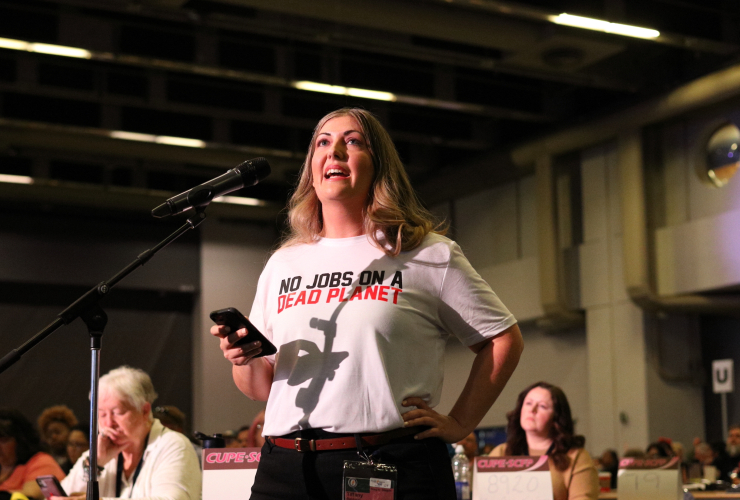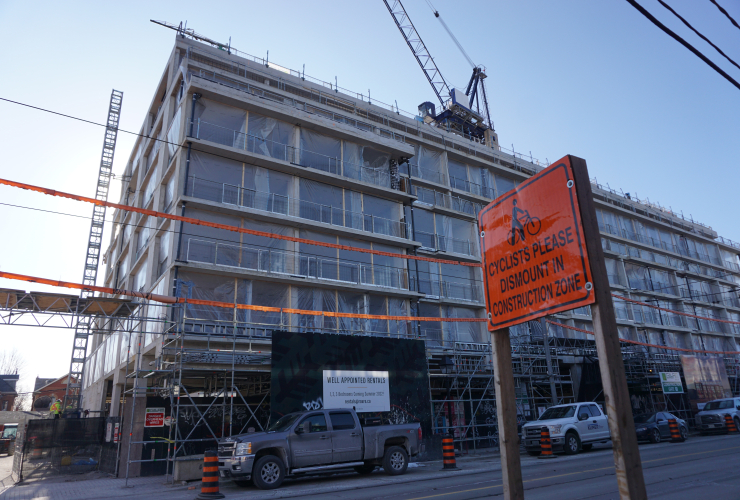While Canada has set a deadline to achieve net-zero greenhouse gas emissions by 2050, several provinces and cities, including Toronto and Prince Edward Island, have made commitments to reach that goal a decade earlier. To do so, all of their existing buildings and houses will need to be retrofitted so they no longer use fossil fuels.
The building sector is the third-largest source of emissions in Canada. In Toronto, buildings make up 58 per cent of the city’s total emissions, mostly from burning fossil fuels for heating, cooling and hot water.
The push to cut these emissions will be expensive. The Pembina Institute estimates the federal government, in partnership with provinces and utilities, will need to invest $10 billion to $15 billion per year over the next 20 years to reach its net-zero commitment.
“This might seem like a big number, but the economic opportunity is significant; this could create up to 200,000 long-lasting, well-paid jobs and generate more than $48 billion in economic development each year,” said Jessica McIlroy, senior analyst for the Pembina Institute’s buildings program.
“Cities and provinces are moving very quickly on net-zero new construction, but it’s important to remember that 80 per cent of the buildings that will exist in 2050 have already been built. To meet our net-zero commitments, Canada needs to upgrade 600,000 existing homes and 750 million square metres of existing commercial space per year between now and 2040.”
That means upgrading insulation and ventilation, and switching from fossil-fuelled heating and cooling to cleaner options, she said.
“These upgrades will not only make homes more energy efficient, they will also make them more comfortable, healthy and able to withstand the impacts of increasingly more extreme weather, like extreme heat, smoke from forest fires, extreme cold and flooding,” said McIlroy.
Experts believe it is possible for cities to hit their decarbonization targets by 2040, but they have to act now, and the shift will require a co-ordinated effort between government, industry and residents.
“There is no single solution because all buildings are different. We need tools to help us rapidly find the right combination of retrofit measures for each building,” Ralph Evins, associate professor of civil engineering with the University of Victoria’s faculty of engineering and computer science, told Canada’s National Observer in an email. “The retrofit rollout will need appropriate financial support, including rebates/incentives and low-interest loans. This carrot will work together with the stick — building owners will eventually be forced to upgrade, whether by rising costs, a carbon tax or other means.”
Evins believes cities need to understand the scale of the problem and incentivize building owners appropriately to undertake the right retrofit options.
“The best solution is heat pumps,” Evins said, and financially, the best time to do it is when furnaces and water heaters reach the end of their life. “Investment is required at that time, so the question is what to invest in — more gas-burning equipment or heat pumps with low-carbon electricity.”
For older structures, upgrading the building envelope — everything that separates the outside of the building from the inside — is also important, he added.
What Toronto and P.E.I. are doing to retrofit existing buildings
The City of Toronto told Canada’s National Observer there are an estimated 475,000 homes and buildings in Toronto. The city has various programs to support building owners with retrofits while maximizing mutual benefits and minimizing potential harms to owners and tenants.
“Through its Better Buildings Partnership, the city delivers a variety of programs that provide funding, expertise and support to help building owners improve energy efficiency and accelerate emissions reductions in residential, commercial, industrial and institutional buildings,” said Jessamine Luck, communications adviser for the City of Toronto. “Programs include the Green Will Initiative and Deep Retrofit Challenge. Through its Home Energy Loan Program, the city offers low-interest loans to support homeowners’ decarbonization and energy efficiency projects.”
Luck said the Net Zero Existing Buildings Strategy advances the decarbonization of existing buildings in Toronto. The strategy includes plans to eventually require Toronto building owners to annually report and disclose their building’s greenhouse gas emissions performance. This is intended to improve both building owners’ and the city's understanding of the performance of Toronto’s homes and buildings, Luck said.
The full financial impacts of the required net-zero investments are still to be determined, but Luck said estimates suggest the total investment required by the city, the business community, other levels of government and individual residents is in the order of $145 billion.
“This number includes the financial investments made by homeowners towards retrofitting an estimated 475,000 homes and buildings, or about 27,000 home retrofits each year until 2040, as well as individual purchases of 333,000 electric vehicles before 2030,” Luck said. “These investments will need to be complemented by provincial government actions to support and maintain a carbon-free provincial electricity grid.”
Prince Edward Island, which aims to become Canada’s first net-zero province, has the same 2040 target. Retrofitting support plans are outlined in Pillar 2 of its Net Zero Framework.
According to Katie Cudmore, senior communications officer for the province’s Department of Environment, Energy and Climate Action, Prince Edward Island handed out $19 million in energy efficiency rebates last year, and nearly 5,000 free heat pumps were installed.
“We have rebate programs for efficiency upgrades to home insulation, energy-efficient equipment and new home construction, along with free equipment for income-qualified households,” said Cudmore. “P.E.I. also has provincial Network of Excellence contractors that offer current information on energy efficiency services.”
Cudmore said the province's Climate Challenge Fund has provided $1 million annually to help organizations develop innovative solutions to address climate change.
Tackle large buildings first, expert says
Mark Hutchinson, vice-president of green building programs and innovation at the Canada Green Building Council, told Canada’s National Observer that right now, Canadian cities and municipalities will not meet climate targets unless they address the need to retrofit existing large buildings, like multi-unit residential buildings, schools and office buildings.
“All together, these large buildings represent approximately a third of Canada’s existing floor space and about a third of building-related emissions. These large buildings also represent as much as half of the emissions reductions that the building sector can achieve,” said Hutchinson.
He said the best solution is a co-ordinated response from multiple angles that supports the transition. At the moment, the onus for retrofits is on the building owners and operators.
The financial feasibility of retrofitting Canada’s existing buildings depends on the building type, vintage and other unique characteristics, Hutchinson said. And not adding to the number of retrofits required is important: If new buildings are designed to the lowest standard, they will likely run on fossil fuels and will need upgrades later. “This is extremely difficult and costly to improve after construction is complete. For example, providing better insulation and windows, or minimizing the heat loss from balconies, is relatively easy during construction, but both expensive and disruptive after. This is perhaps the greatest concern,” he said.
Upgrading a major building system is more complex than simply replacing equipment, said Darla Simpson, retrofit program manager at Zero Emissions Building Exchange. And building owners need support to make informed decisions about decarbonization.
Other cold-weather countries are transitioning, she noted. “We're not reinventing the wheel, but we need to co-ordinate and focus our efforts to do it at the speed and scale required,” said Simpson. “Decarbonizing buildings by 2040 is possible, but we have to act now. Most mechanical systems need to be replaced roughly every 20 years, so we have a window of opportunity.”
With increasing extreme heat and wildfire events across Canada, Simpson said decarbonizing buildings will improve climate resilience. “Insulating buildings reduces indoor maximum and minimum temperature extremes, heat pumps provide both heating and cooling, upgraded ventilation systems can improve air quality; these are just a few examples of how decarbonizing our buildings can help Canadians prepare for climate change while preventing more extreme climate disruption.”
This story was produced in partnership with Journalists for Human Rights for the Afghan Journalists-in-Residence program funded by the Meta Journalism Project.






Comments